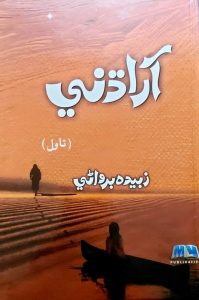
One can confidently say that ‘Aradhni’ is one of the unconventional creations of fiction in conventional times of Sindhi Literature.
Meer Mansoor
Fiction is one of the best and the easiest ways to depict factual stories in a fictional way, presenting events chronologically shows the artistic and lynx-eyes of a writer. One common thing has been noticed in most of the landmark pieces is that the “requirement of time.” For instance, it was the need of hour for Gorky to write Mother for enlightening proletarians; Harriet Beecher’s master-piece Uncle Tom’s Cabin for fanning the flames of Civil War; The unprecedented works of George Orwell and William Golding’s to show the corruption of so-called Democrats, Theocrats and Autocrats. The depiction of Austen elucidates the problems of Aristocratic masses. Harold Pinter and Beckett’s absurd theatres heed to the meaningless of life and the decline of human wisdom that nothing would happen.
Similarly in the subcontinent, partition becomes a favorite subject of writers like Saddat Hassan Manto, Kirshan Chander and Qurratulain Haider who put their heads together to depict the sufferings of people on both sides, and their friendship divide on the basis of religion.
In Post-modern times, a number of writers are more readable as they are friendly-read for the masses. Margaret Attwood, Paulo Coelho, Ishiguro, Elif Shafak, Arundhati Roy, Mohsin Hamid, Hanif Qureshi, Amer Hussain and so forth. In Urdu, Jamila Hashmi, Ali Akbar Natiq, EM Akhtar and so on. In Sindhi, Rasool Memon and Akbar Soomro inspire readers by their content.
The first novel of Akbar Soomro Tale of City was much inspiring as compared to his recently published Khumaach. Rasool Memon’s Palmist is one of the best novels that must be translated in many languages.
 However, the recently published novel Aradhni written by Zubaida Birwani, renowned environmentalist and writer, opens up new discourses on mysticism by fictionalizing an intuitive Sufi character Mansoor Hallaj. Although, Jamila Hashmi has unequivocally done a brilliant job on the same ground, but seems unable to make her work post-modern. Birwani has skillfully made post-modern piece by depicting Sufi characters in a modernized way, they do not seem busy in prayers and whirling rather they deliver lectures and inaugurate institute of Anthropology.
However, the recently published novel Aradhni written by Zubaida Birwani, renowned environmentalist and writer, opens up new discourses on mysticism by fictionalizing an intuitive Sufi character Mansoor Hallaj. Although, Jamila Hashmi has unequivocally done a brilliant job on the same ground, but seems unable to make her work post-modern. Birwani has skillfully made post-modern piece by depicting Sufi characters in a modernized way, they do not seem busy in prayers and whirling rather they deliver lectures and inaugurate institute of Anthropology.
Besides, the addition of inter-textuality has also a great impact on Post-modern creations. In this regard, the conversation of Yunus Emre with his mentor Tapptuk Emre adds new spirit in the text. Ibn ul Arabi, Maulana Rumi, Shah Abdul Latif, Shams Tabraiz and couplets of Hallaj are not only well speculated but also theorised them with contemporary times. Therefore, it is a blend of history and mysticism and love longing.
The whole story revolves around six major characters; Aradhni, Mansoor, Masood, Shibli, Shams and Meeral. It is beyond doubt that the art of characterization is marvelously portrayed by the author that reminds Mirages of the Mind from the humoristic pen of Mushtaq Ahmed Yousifi. The story follows in a way that Mansoor spreads enlightenment and wisdom through his transcendental and Sufi parlances that cannot be digested by pseudo-religious minds who supposed to file a case of false allegations in order to imprison him. In certain circumstances, his beloved Aradhni comes back from Konya after a couple of years. She supposed to meet Jail Superintendent-Masood- who informs her about the high profile case of her beloved, she losses her senses and utters stunner words for beloved that become cause of inspiration for Superintendent who keens to learn more about Mansoor. After knowing the illustrious side of Mansoor’s life, he also follows the imprints. Journey of Shibli and Shams begins with Aradhni, for her, they become a sole source of catharsis. In the beginning, her relation with Mansoor waving a ray of marriage proposal but later on gets mature and brings a laudable change in both lives; they start to think of eternal life. The story concludes with arresting and striking scene on court’s hearing day where Mansoor has terribly attacked by religious people, he breathed his last in the lap of Aradhni. While performing all funeral responsibilities Aradhni encounters with the light of Mansoor’s soul who hands over a draft of Aradhni novel. So, she shoulders responsibility of Mansoor to enlighten people with the manuscripts that he used to write in jail.
So, one can confidently say that it is one of the unconventional creations of fiction in conventional times of Sindhi Literature. The narrator narrates mystical enlightenment through lectures of protagonist character-Mansoor. For instance, chapter eighteenth elaborates multiple mystical concepts and throws light on mystical thought from a number of authentic religion sources. The mentioned chapter must have to be included in the course work of comparative religion, students and scholars will surely explore new horizon of Sufi teachings from their respective fundamentals.
Apart from that the novel has been written in a feminine perspective therefore protagonist character seems marginalized though he surrealistically hands over the draft of Aradhni, but narrator fails to generalize the text. Despite the fact that it’s her first attempt, the author has indubitably succeeded in many ways; suspense plays crucial role in fiction, in the entire text, author has successfully hooked up reader’s attention it seems as though the novelist has hypnotized her audience with striking scenes. Meanwhile, there is no room for criticism rather adoring words must have to be showered that would surely not turn into stones to block her creative paths but they motivate her to give unconventional writings as per the requirement of twenty-first century’s Sapiens.
__________________
 Meer Mansoor is a freelance writer.
Meer Mansoor is a freelance writer.